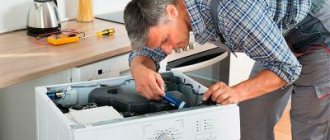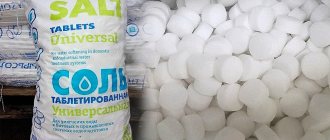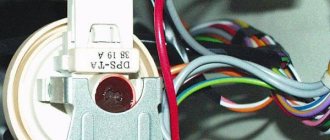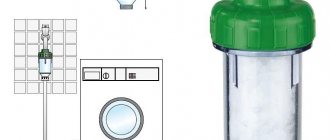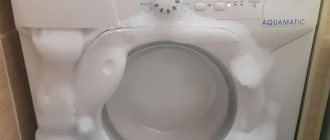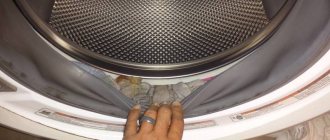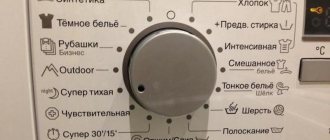You loaded the laundry, set the desired program, and the washing machine began to fill with water. In the first minutes, everything was going normally, but at some point it became clear that the collection of water did not stop at the right moment, and there was a lot of water in the drum.
Note! In some cases, its level can even rise to half the tank.
After this, the drain pump turned on, the water that entered the drum went into the sewer, and the machine stopped washing and displayed an error message in the form of a message on the display or a combination of flashing indicators. If this happened to your washing machine, then you are faced with an overflow of water into the machine.
Attention! Do not confuse overflow with a similar problem where the washing machine constantly fills with water. In this case, the normal amount of water is poured into the drum, it is simply drained at the same time, so the machine is forced to constantly add water. The execution of the program may not stop until the owner stops the machine manually. If your machine constantly takes on water, read another article.
How dangerous is water overflow in a washing machine?
Many non-professionals who do not understand the structure of washing machines “scare” users with the dire consequences of overflowing. They say there is a high risk of flooding your neighbors or flooding the electronic control unit of the car itself. In fact, most modern washing machines have built-in overfill protection. As soon as the water level in the tank reaches a critical level, the overfill protection is triggered, the water is drained, and the device displays an error message. The risk of flooding your neighbors or damaging the electronic components of the device itself exists only in very old automatic machines, mostly domestically produced.
The reason why a washing machine overflows water, according to the experience of the RemBytTech workshop, most often lies in a breakdown. Only in rare cases can the problem be fixed on your own.
Incorrect connection to sewer and water supply
Often, users want to save money on connecting a new washing machine and install it themselves, not always following clear installation rules. So, for example, you need to know that the drain pipe must be installed in the sewer at a level not lower than 50-60 cm. If it is located below the water level in the tank, it will spontaneously flow out of the machine. The machine will constantly retrieve it. The powder will go down the drain, and as a result, the quality of the wash will suffer.
If you need to make sure that water flows out of the tank uncontrollably, you need to press pause while draining. If you hear that water continues to drain, it means that the machine is not connected correctly to the sewer system. In this case, you need to call a specialist to connect it correctly.
The washing machine pours a lot of water - when you can fix it yourself
If the problem occurred for the first time, then there may have been a one-time failure of the control module. There is only one solution - unplug the washing machine from the outlet for a few minutes, and then turn it on again.
If “rebooting” the device did not help, then most likely one of the machine components has failed. Most likely, the water overflow is caused by a malfunction of the pressure switch (water level sensor). According to statistics, in 90% of cases the reason why the washing machine takes in a lot of water is a failed pressure switch.
The water drains itself
If the machine initially pours the required amount of water, but during the washing process it leaves for some reason, then the unit constantly replenishes the lost water. As a result, the heating element is constantly turned on, because he needs to heat the water to the required temperature. The washing process increases.
Why can water drain spontaneously? This may occur due to increased pressure in the sewer or improper installation of the machine. In this case, you need to install a special anti-drain valve on the drain hose. It will prevent water from draining from the tank on its own.
Possible breakdowns
Based on the experience of RemBytTech specialists, we have compiled a list of the main breakdowns that lead to water overflow. You can check them out below.
Faulty pressure switch (level sensor) - from 1400 rubles.
The pressure switch tube has fallen off, become clogged or damaged. The pressure sampling chamber of the level sensor is clogged with scale and dirt, or the sensor itself has failed.
Signs
The washing machine collects a large amount of water (its level can reach the middle of the drum), then immediately drains it, stops the washing program and displays an error message (water level sensor).
How to fix
If the pressure switch tube has fallen off, become clogged or damaged, it is necessary to put it back on accordingly, blow it out or replace it with a new one. A clogged pressure switch chamber must be cleaned. If the sensor itself fails, it must be completely replaced with a new one.
Faulty electronic controller (control module) - from 2000 rubles.
During flooding, the controller does not give a command to stop drawing water, and it continues to flow into the machine.
Signs
The washing machine overflows water, after which the water is drained and the wash stops. It is also possible that the machine displays an error in the form of a combination of flashing lights or a message on the display.
How to fix
The control board needs to be repaired or completely replaced.
The filling valve is out of order - from 1500 rubles.
It is stuck in the open position, so water constantly flows into the machine and it cannot finish the program.
Signs
The washing machine constantly draws water after starting the wash or when switching to rinse. The program does not complete and an error may appear.
Damaged inlet valve
The most dangerous problem that causes the washing machine to constantly fill with water is a defect in the fill valve, which serves as a barrier between the water supply and the machine mechanism. When the “fill” command is received, the valve opens and liquid begins to be drawn into the powder compartment and further into the tank. When the chamber is full, the signal goes to the control unit, and from it back to the valve, and it closes. If it is broken, that is, it does not block the pipes, moisture will enter the system even when the device is turned off or the hatch is open. If the pressure switch is working properly, the device will drain immediately. If not, the room will be flooded. The only way to stop the flow is to shut off the pipes.
Like the previous element, this valve breaks in different ways. If only the inner membrane is faulty, flow will be weak. It can be replaced. But if the flow is strong and filling occurs quickly, it means that this part cannot be repaired, you need to install another one.
Inlet valve failure occurs in Whirlpool, Bosch and Ardo brands.
Control module problem
The most difficult problem, which is unlikely to be solved on your own unless you have special skills and knowledge, is a breakdown of the control module. It is from there that commands come, including to the intake valve. Contacts in any section of the module may burn out. Reasons for this phenomenon:
- ingress of liquid or detergents into the contact system;
- short circuit in external networks;
- too much load on the contacts of the heating elements.
If this failure occurs, the control module will most likely need to be replaced.
What to do?
The easiest way is to entrust the repair to professionals. In the meantime, remember the old way of washing - by hand. If you are not going to give up, then you can try cleaning the contacts of the control module. To do this, you will need a special liquid that needs to be injected into the section where there are burnt contacts. If the deposit is small, then this simple action can be quite effective.
DIY repair
Depending on the problem, repairs may vary. Some problems can be fixed with your own hands, while others can only be dealt with by professionals. DIY repair methods:
- If there is water on the line, but the pressure is very weak, you can simply continue washing, but regardless of the program, the washing process will take a little longer. If this option does not suit you, then you need to call the utility company and find out why the dialing has been reduced and the time frame for restoring problems on the line.
- The water supply to the washing machine can be turned off using a special tap. If it is not fully open, water will be drawn in, but very slowly. The fix is easy. If the valve is open completely, but it is clear that this is the reason, the valve itself may break down, then it will have to be replaced.
- Sometimes water does not flow well into the washing machine because the inlet hose is kinked. It is necessary to check for this problem and straighten the hose.
- At the entrance to the washing machine, where the valve is installed, there is a special filter. At times it becomes clogged, and then the liquid flows into the washing machine is weak. If you clean it, the problem will disappear.
DIY machine repair
In the case when the inlet valve or electronic module is broken, it is better not to fix the problem yourself, but to contact a specialist. Fixing the problem yourself can lead to a complete malfunction.
Diagnostics of a malfunction of the pressure switch water level sensor
Very often, the cause of a lack or excess of water is a malfunction of the water level sensor. It is inexpensive, but the main difficulty in independently diagnosing a malfunction of the pressure switch is the need to disassemble the washing machine.
Sequence of actions when diagnosing a malfunction of the pressure switch:
- Let's disassemble the machine.
- We unscrew the sensor itself and disconnect it from the tube.
- We blow into the pressure switch hole. If the part is working properly, clicks will be heard. Their number corresponds to the number of programs.
- We examine the tube. If it is damaged, it needs to be replaced. If dirt and deposits are visible on its walls and in the lumen, it must be cleaned and rinsed under running water.
- We're putting the car back together.
If your Samsung, LG, Ardo, Zanussi, Bosch, Electrolux, Beko, Indesit, Candy, or any other washing machine has stopped working, contact FixWosher. Our technician will quickly and efficiently repair your equipment. The cost of repairing a washing machine will depend on the damage identified and the complexity of the repair. You can leave a request on the website or by phone; the company is open from 7:00 to 23:00.
Water supply hose problem
If this does not help, check the hose to see if it is broken or if there is something heavy on it that could impede the flow of fluid. Another factor affecting the set is a clogged hose. In this case, liquid can flow into the unit, but very slowly and with little pressure.
What to do?
If there is anything on the hose, remove it. It may be damaged, then you will have to replace it with a new one. If clogged, you need to disconnect it from your unit and rinse it well under strong pressure.
The filter mesh is clogged
A common factor that influences the machine not drawing water or doing it very slowly is a clogged filter mesh. It is located in front of the inlet valve and is designed to protect the unit from small debris that may enter from the water supply. But, since the quality of water often leaves much to be desired, this mesh can become clogged and prevent liquid from passing through. Or the pressure will become very weak.
What to do?
You can call a technician to clean the filter mesh, or you can try to deal with the problem yourself. To do this, you need to turn off the valve and disconnect the hose at the place where it connects to the washing machine. Then clean the mesh from any accumulated dirt and rust. After this, rinse the hose itself under high pressure.
What are the causes of water overflow
A large amount of water in the drum may not always be a sign of a malfunction of some machine parts. For example:
- Some Ariston units have a built-in “Anti-shock” function, which is triggered when the temperature regime is violated before draining the water (for example, spinning or rinsing).
- The system of protection against excessive foam formation is triggered, as on many models of Ardo machines.
- More water is drawn into the tank in the “Delicate Wash” mode - this is done on LG washing machines.
But these are isolated cases, and at the moment we are talking about systematic overflows of water during washing. The main reasons for the washing machine to collect a large amount of water are as follows.
Heating element malfunction
If the heating element responsible for heating the water breaks down, the washing machine stops drawing water, and many other functions stop working. In this case, the rinse mode should work, because it does not require heating. If the problem really is a breakdown of the heating element, then you will notice this by other signs: after washing, the laundry remains dirty and has an unpleasant odor, the door remains cold.
What to do?
To solve the problem, you need to replace the heating element.
